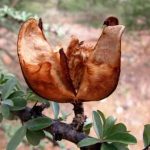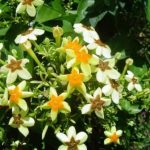TREE LIFE
JANUARY 1992
MASHONALAND CALENDAR
Sunday 22nd December : All the details For our Christmas social at Ewanrigg were in Tree Life No. 142 except the time. Apologies We are meeting at Ewanrigg at 9.30 a.m.
Tuesday 7th January : Botanic Garden Walk at 4.45 for 5 p.m. Park at the Herbarium where we will meet Tom Muller.
Sunday 19th January : Tsindi Ruins, Theydon, Marondera Area. 100 Kms 1.5 hours.
The Tsindi Ruins (formally known as the Lakkerwater Ruins) are South-east of Harare not far from Marondera on a prominent granite hill. From excavations made in the 1960’s it appears that the First walls of the settlement were built in the thirteenth century and were added to in the fifteenth century. They are of the same type as those found at Great Zimbabwe. During the seventeenth or eighteenth century two large clay huts were built within the enclosure; it is believed they were used for ceremonial purposes.
An interesting place historically as well as botanically. Some of the trees to be seen there and which are seldom seen in the Harare area are Diospyros whteana, Olinia vanguerioides, Schrebera alata, Apodytas dimidiata, Cussonia natalenenis, and Solanacio mannii.
We will meet at 10.30 am in the parking area, at the ruins where there is a National Monuments guard on duty to watch the cars. If you’d prefer to have your lunch on top of the Kopje, (and it is not a strenuous climb, and the view is wonderful) bring a portable meal.
Saturday 25th January : Walk with Mark on the Borrowdale Common. We meet on the Corner Lanner Avenue and College/Teviotdale Road (From town just after crossing a little bridge on College Road). On our last walk on the common in September the many plant species were just emerging – their progress will be most interesting.
Tuesday 28th January : A real treat – at 7 pm in the lecture theatre at St. George’s College. Mr Lyn Mullin’s talk which will be illustrated with slides is called ‘A Heritage of Trees‘. It covers trees of historic and spiritual interest, of‘ unusual size and of rarity, e.g. the only known Juniper in the country. Teas will be served in the course of the evening. Although there will not be an entrance fee, there will be a collection so that costs may be met.
MATABELELAND CALENDAR
Wednesday 18th December l99l : the last McHew off the year — exams are finished, you can come back now! 5.00 pm at Hillside Dams.
Wednesday, lst/January 1992 : Must of you have been signed up already by Angie for the New Years Party at the Blakes – roll up from ll.30 am – and just see what happens! Please bring chairs – umbrellas (sun or rain) and of course all those eating and drinking goodies a la Angie! Phone 61384 (work) or 62229 (home) for directions – see you there!
Sunday 5th January 1992 : Just to see if you have recovered from the previous Wednesday, we will spend the morning at Mabukuwene, Chipping Way’, Burnside. There are several parts we still haven’t visited and it shouldn’t be too strenuous! Bring tea-time and chairs and meet there at 8.30 am.
Wednesday, 15th January 1992 : Hopefully, if we give Ian some leaves, he will continue the exciting McHEW’s in the new year — 5 pm at Hillside Dams.
17 NOVEMBER 1991 : HARARE OUTING TO THE MEADOWS FARM, ENTERPRISE
For this month’s outing we were very pleased to be hosted by Dave and Jackie Simleit on their wine estate, The Meadows, on the Mutoko road. Whilst the opportunity to taste a little wine was not denied us, this had to wait until our lunch break from treeing which was in fact our chief objective. This was indeed a memorable day, not only on account of the trees, some of which were of exceptional size, but also for the unexpected added touches, courtesy of our hosts.
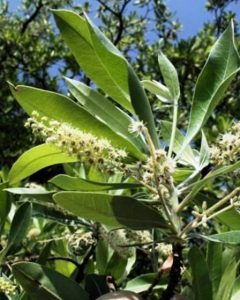
Terminalia sericia. Photo: Mark Hyde. Source: Fora of Zimbabwe
In the past, we have from time to time enjoyed the pleasure of travelling through a farm upon a tractor drawn, trailer. On this occasion though, it was a unique ride on a trailer drawn by a pair of oxen, appropriately yoked together under a yoke made of the traditional Terminalia sericia or yellowwood/mususu. This took us through the vineyards to an area of riverine bush, on a tributary of the Mubvinzi river, where it did not take long before we were speculating on the question of whether we had ever before in our lives seen trees as large as the ones we were seeing. This certainly applied to a grove of Salix subserata willows, not really in the river bed but on a small flood plain. Several of these were large enough to have yielded several cricket bats, but then I’m not sure that anyone has ever attempted to use our indigenous willow to fashion the traditional cricketing ‘willow’. A little further downstream we started bumping into several Myrica serrata, one of which in particular was of exceptional size. This is commonly called the waxberry, and is well-known for yielding an oil which, interestingly, is not a wax but indeed an unsaturated fat. One keen-nosed member observed that the aroma given off from the leaves was not unlike that of floor polish. Some other interesting finds in this area included Rhamnus prinoides, Olea europea subsp. africana, a substantial Acokanthera oppositifolia, bushman arrow poison, and a fair sized Euclea racamosa_.
Moving on to what I call the woodland area we encountered some sizable Combretum collinum which in some parts are so common as to become virtually the dominant tree species. At the point where we again debussed from the trailer was a Burkea africana, (mukarati) which took the honours for being the largest in my recollection. Then not far off through the bush was Boscia salicifolia of not only superlative size but also of most elegant shape. Vary obligingly, this was also in fruit. Perhaps there’s something in the soil at The Meadows that promotes growth for a few metres off was the First of a collection of Securidaca longepedunculata (violet trees/mufufu), several of which would again have beaten the record in my recollection for being the biggest ever.
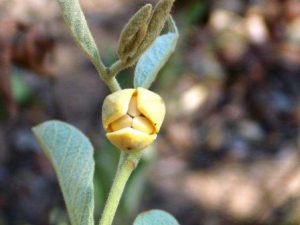
Annona stenophylla. Penny English. Source: Flora of Zimbabwe
On our way down to our next pick-up point, (by way of a slight divergence from trees as such) we stumbled across the ‘other’ Annona namely Annona stenophylla.From time to time in this part of the country we encounter the small tree A.senegalensis but A.stenophylla is but a small plant with stem, a few leaves and the fruit above ground, but with the fruit closely resembling that of A.senegalensis. I’m not sure, whether this qualifies to be called a suffrutex.
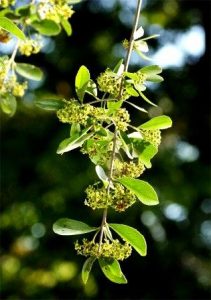
Cassine transvaalensis. Photo: Bart Wursten. Source: Flora of Zimbabwe
From this pick-up point we proceeded not far along until we came to a termite mound on which was what had been billed as the mystree. Many theories were advanced, and I suspect suppressed, until the eventual denouement disclosed this next giant to be a Cassine transvaalensis, a.k.a. one of the koodoo berries. Yet again a never in my life sized tree.
For lunch we proceeded to a well chosen shady spot on the Mubvinzi river where we were treated to some delicious chilled white wine complete with a nyala on the wine label. What a pleasure!
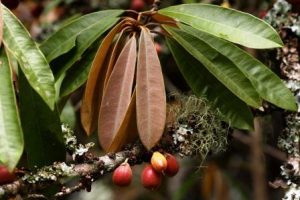
Bequaertiodendron magalismontanum. Photo: Bart Wursten. Source: Flora of Zimbabwe
Despite some members feeling slightly worse for wear after lunch, we trekked trans treed and trellissed territory to the far side of the farm to a slightly different riverine area, where further mega-trees awaited our attention. Amongst some delightfully Fresh-looking Bequaertiodendron magalismontanum we observed what I dismissed as a common Lannsa discolor. However, the more observant in the party soon queried this identification. After some thought we concluded that we were in fact seeing Ekebergia capensis, which is a fairly rare observation here on the highveld. This was later confirmed at the herbariun. I last recall having seen this below the dam wall at Mazowe.
We are accustomed to seeing Dovyalis zeyheri as something of a small tree or bush. However, it was with considerable surprise that we identified a very tall tree as such on the river bank, for in order to confirm the identification it was necessary to send a climber up the tree trunk several metres off ground level to recover leaves. We were all left incredulous. Then soon after we encountered a Maytenus undata which again left me saying ‘never in my life‘. Perhaps the smaller examples which we usually see are on the granite koppies and so do not benefit from the ample water supply which this riverine specimen obviously enjoyed. A little Further along with its ‘Feet’ well in the water was an Ilex mitis (African holly). It is always a pleasure to see llex but what intrigued us was that this specimen had a ‘handle’ on one side, meaning that a branch from a lower level had grown up and above had rejoined the trunk, presumably the result of rubbing, which then enabled the two parts to graft together gain.
It was indeed a superlative day and we extend many thanks to Dave and Jackie.
-Phil Haxen
THE PACE OF THE OX
What do we know (and what do we care) of Time and his Silver scythe?
Since there is always time to spare so long as a man’s alive
The world may come, and the world may go, and the world may whistle by,
But the Pace of the Ox is steady (and slow), and life is a lullaby.
The song of the ships is Far to hear, the hum of the world is dead,
And lotus life in a drowsy year our benison instead;
why should we push the world along, live in a whirl of flame,
when the Pace of the Ox is steady and strong and the end is just the same?
By Cullen Gouldsburg, From Rhodesian Rhymes_._ Verses l and 4
BLAKES’ RAMBLINGS
We in Bulawayo have uncovered a ‘mystree”. Thanks to Peta’s surveyor friends, Rhigozun brevispinosum has come to light after about 16 years. A bush was found with beautiful yellow bignonia flowers in the Hyde Park township area of Bulawayo, and we started the search for others. As it has a very short Flowering season we had to jump around, and strangely enough we had a races to Mguza Nature Reserve and once again the bundu had turned yellow. The strange thing is that the Hyde Park variety, which is in a very inhospitable overgrazed moon landscape has enormous (4 cm) decussate spines, whereas in the more congenial surroundings of Mguza the bush has either no thorns or very short ones — who says that plants have no brains? This shrub can also be confused with Cadaba termitaria which we have so far been very excited with in Mguza, but now our calendar has been marked to go and check for the very different flowers which we hope will appear.
Any visitors to Bulawayo should take a trip to this new Mguza Nature Reserve, just out of Bulawayo on the Victoria Falls Road. It has been stocked with quite a lot of animals, has a very varied terrain, contains a fair—sized dam, a sometimes running river with weirs, a hide and pan, and picnic sites. At one particularly scenic rocky chasm viewpoint, there are a very varied collection of trees in quite a small area, namely, the usual Euphorbia espinosa, the beautiful croton Croton gratissimus, Erythrina latissima, a great Ficus abutilifolia all doing the right things over the rocks, the smelly leaved Clerodenrum myricoides and Pavetta gardenifolia and some lovely specimens of Elephantorrhiza geotzei, Pterocarpus rotundifolius, Ochna puberula, O.pulchra, Colophospermum mopane and Kirkia acuminata, and over lapping the aloe and succulent plants, there are magnificent specimens of Aloe excelsa and A. chabaudii, and hidden among the rocks Anacam seros rhodesica, Stapelia nobilis and Huernia hislopii, Euphorbia schinzii and E.griseola, and Vellozia eqiuisetoides (brushes and brooms) – a very accessible and enjoyable amenity for Bulawayo.
Continuing along the Falls Road, as we did last weekend, you get to Hwange Game Reserve after, of course, noticing along the way Guibogtia coleosperma, some really beautiful Terminalia sericea in their various silver-green shades, and then we drooled over the flowering Baikaea plurijuga (the purple teak flowers) and the lime-green of the ordeal tree, Erythrophleum africanum. Although devastated in patches the roadside is still a delight for bird cow tree watchers!
Hwange Game Reserve is lovely and green, although not much rain has fallen, making some pans real disaster areas, but we still had a count of some 20 animals (including a new one for us side-striped jackal) – 121 species of birds (including close views of scope owl and kori bustard) and myriads of trees – including the Acacia luedaritzii (sand veld acacia) in the Jambila Picnic Site, the amazing colours of the young Baikaea plurjuga in the Ngwashla area, several very large Acacia galpinii and many colourful Colophospermum mopane tress — not bad for just an ordinary weekend.
And on the subject of travel, we really enjoyed Tessa’s articles on Namibia – as we went there in 1965 and 1973 before the days of tourism proper, with no maps and no information, it was very interesting for us. I hope Tessa will elaborate more on some areas? what really brought a smile to my lips was the fact that the sand dunes moved across the tar road near Luederitz — in 1973 the 250 mile trip from Lueritz to Keetmanshoop was proudly proclaimed “the worst road in Africa” – so much so that the corrugations loosened the windscreen in the rubber surround on our Standard Vanguard – those were the days.
-KEN and BETTY BLAKE
NYARUDINDA CATCHMENT DECEMBER 1991
Trees ‘n‘ Travel : On the eve of our leave Miles Standish-White breezed in here on his beat around the countryside, “I wonder if you know what this is’?, it was growing near the entrance to the Botanic Garden”. It reminded us of a fruiting twig of avocado pear. Its identity cropped up in an unexpected way; this happened in Cagnes-Sur-Mer in France where we stayed with an ex Wye College friend. we found something to read whilst he prepared the meal, the Sept/Oct. edition of the World Wide Fund for Nature (WWF) newspaper showed a photo of jak or jack fruit with foliage, this was IT and it belongs to MORACEAE, its genus is Artocarpus, that of breadfruit. .
“A Vision of Trees in Madagascar” was the title of the article accompanying thepicture of this fruit ….. “Chief Bakery had a vision in which his ancestors revealed that God gave us four important trees for life: the mango tree for its sweet fruit and plentiful shade; the kapok or silk cotton tree for its fruit fibres to weave mats to rest and meditate on. He gave us the avocado tree so that we can sell its fruit and make a profit, and finally God gave us the jack fruit tree as a symbol of Friendship. By knocking on the fruit we can tell if it is ripe by the sound it makes. Therefore it is our friend because it can communicate with us.”
Readers‘ Feedback would be welcome for two reasons, at which entrance to the Botanic Gardens is this tree situated, and what is the specific name of this Artocarpus?-
In Cagnes we stayed in an old stone-built house in a very steep, very narrow Street going up this hill to bed made us puff after wining and dining the Provence way. Appropriately our holiday reading was the best seller “A Year in Provence”, this book has an appeal to anyone with concern for the land and the people who lead their lives close to it. We noticed that “our” Rue Hippolyte was marked with white lines like bays for a line of three or four cars. Nils, our friend, explained that on one day during “the Season” this court was used for the game ‘Boules’. Possible because the boules were blocks of wood instead of heavy gleaming spheres of steel. Chunks of ancient Olea africana would feel right for this game, it has very heavy wood. Around us olive trees, Aleppo pines and houses competed for space on the hillsides of La Cote d’Azur. Provence is the place to find olive wood carvings, but perhaps we need go no further than Bulawayo to see pieces carved by Bob Aveley. More information on this topic could be of interest to readers of “TreeLife”, come in Bulawayo ……. . ..
We visited the home, now a museum, and the estate in Cagnes which belonged to , Pierre-Auguste Renoir, its was difficult to drag ourselves away from this beautiful place, as we looked back we noticed a strawberry tree in fruit in its Mediterranean homeland. Previously, in Eire, this species was shown us by the driver of a horse- drawn jaunting car in the Killarney National Park, “There’s Arbutus.” It was his accent which made it special, how many sight—seers would have understood what he implied. The strawberry tree is native to Ireland, a country which has few indigenous trees. There will be more on this topic next month.
The Catchment October 12th : Green grass, the smell of showered earth and bird song welcomed us home. We returned to find a young Zanha africana with accessible flowers, they are insignificant, they do not have petals, their scent attracts pollinating insects and sometimes the trees are laden with bright orange fruits which are decorative at Christmas time, they should not be eaten.
The Ochna gambleoldes with a forty cm. long gash in its six cm. trunk excelled itself in October by having more than a dozen clusters of flowers, twice as many as last year. This is its third flowering season, it merits a photograph because the conspicuous black Fruits are weighing-down the short stout lateral branches. Unfortunately we arrived home too late to see its short lived gold petals.
Quite recently, November now, the grandchildren (with sharp eyesight, closer to the ground than ours) found and brought home a dry brown Diosgyros kirkii leaf which cupped a deposit which resembled dried coconut, this consisted of empty egg cases and very small coral—pink spiderlings which have anchored their leaf with a fine transparent web to the shelf near the back door. Minute flies and crawling insects become trapped, these seem to be the only source of water and food for the spiders which were found on the ground in Brachystegia woodland. What will becomes of them? We shall see and let you know.
Solitary Pericopsis angolensis, muuanga, trees in the catchment no longer stud the countryside with dark brown foliage, it has merged with all the green of summer. Now is the season when bushpig root for maize pips, infant geckos explore the walls, house snakes and others make us freeze. Senegal coucals call and also cuckoos of many kinds. Sometimes the striped cuckoo is reminded by the first drops of rain that it should have foretold them. Tecomaria capensis blooms are hastily probed by white bellied sunbird. It is the tick season again.
Remember to collect ripe Ximenia fruits and liberate the kernels so that they dry sufficiently to light them when threaded on wire, a New Year candle …_.’ Best wishes for a peaceful Christmas and good fortune for the New Year.
We were pleased with Fiona Dawe’s information concerning Botanical and National Numbers and For explaining the technique which taxonomists use to slot in new names of genera and species.
It is good to see Mrs Peggy Izzitt’s writing, this time in the Prehistory Society Newsletter, issue 84, October 1991. In issue 76, October 1989 Lorraine Adams wrote about the chronology or time-scale based on a trees growth rings. There is a laboratory of Tree Ring Research at the University of Arizona. This is where trees have been categorised for being sensitive or complacent in their reaction to changes in annual climate. Sensitivity and Complacency vary among species and even between species belonging to the same gems. The environment of a tree is important eg a tree growing in well-watered fertile soil is likely to be complacent.
The antiquity of bristle-cone pine has been established by the study of growth rings, its sequence extends back many thousand years. Living trees of Pinus aristata have clung to the mountain tops of‘ the “Rockies” for more than 4000 years, their story is fascinating.
Lorraine concluded her description of the very basic principles of dendrochronology with the following paragraph:
“It may be possible for a sequence to be calculated for the Eastern Highlands region of Zimbabwe based on the species Tarenna pavettoides. J G Storry wrote in 1975 about some initial experiments, but the work has not yet been followed up”.
With reference to “The Zimbabwe Bulletin of‘ Forestry Research” No. 9 “The Indigenous Timbers of‘ Zimbabwe” the above paragraph concerns large-leaved Tarenna which grows in moist evergreen forest of the eastern border at medium altitudes.
Would the experts describe this Tarenna as Sensitive or Complacent in this cushy environment?
From the description of the timber, it seems a good choice for research, it has well defined growth rings and almost no seasoning defects. Disadvantages could be its limited occurrence and susceptibility to attack by insects and Fungi. To conclude this topic it may be worthwhile to note that Tarenna pavettoids occurs not too distant from the sites of the Nyanga terraced hillsides and hilltop settlements. Growth ring research could reveal and/or confirm changes of climate during this period of Agriculture. Perhaps this is a festive season Flight of Fancy. CHEERS I.B.M.G. _
Help ! Help. Fiona has ground to a halt in the middle of a large labelling commitment and desperately needs Alginate or pool acid containers and Handy Andy bottles.
Through trial and error it has been found that homemade labels cut from white plastic are a reasonable substitute for the very expensive commercial products.
So please save all your containers and hand them to any committee member at the outings or walks. Or phone Fiona Dawe at home on 45404 or Maureen Silva-Jones at work on 739711 to arrange collection or delivery.
INTERCHANGEABLE PLANT NAMES Some while ago, a note appeared in a British botanical magazine about pairs of species where sthe specific names of one refers to the generic name of the other and vice versa. The only example given was that of Aquilegiathalictrifolia and Thalictrun aguilsgifolium.
Recently I came across a similar sort of thing in the pair of wood species Tarenna pavettoides and Pavetta tarennoides. Not surprisingly, Aquilegia and Thalictrun are fairly closely related as also are Tarenna and Pavetta.
Can anyone think of any other pairs ? M A H
GIANTS : The Inodzi eucalypts near Penalonga
The trees were planted in about 1905 in a moist gully covering O.44 ha at an altitude of 1340 metres in a region receiving an average annual rainfall of 1500 millimetres. Two species were planted in a rough proportion of 80% Eucalyptus grandis and 20% E.microcorys.
The first measurement of the stand was made in l921 by Dr J S Henkel, the first Forest Officer in what was then Southern Rhodesia. Henkel calculated that the mean annual volume increment of the stand was 70 cubic metres, a figure that was dismissed as fanciful, but which was proved correct. He also calculated that the site was capable of carrying a volume of 3 36 0 cubic metres p
The next full-scale measurement was carried out in 1957 for probate purposes by two officers of the Forestry Commission, who found 240 trees on the stand – 194 E.grandis and 16 E.microcorys — containing a total volume of 3 438 cubic metres. The tallest E.grandis was measured as 85.2 metres, but the tallest E.microcorys was not recorded. A further measurement in 1975 showed that 64 trees had been removed in unrecorded thinnings, reducing the stand to 136 E.grandis and 41 E.microcorys, but I have no details of the other results.
The last measurement, initiated by me for a work conference of the International Union of Forest Research Organisations, was made in March 1984 with more sophisticated instruments than were available previously. The tallest E.grandis was 73.6 metres and the tallest E.microcorys 64.5 metres. The total volume per hectare was calculated as 3 339 cubic metres.
The discrepancy between the 1957 and 1984 heights was probably due to the extreme difficulty of measuring such tall trees accurately in a steep-sided gully with the simple instruments available in 1957.
One small plot of 20 E. regnans in Zimbabwe that may be worth noting was planted in 959 at Stapleford Forest (altitude 1750 metres, annual rainfall 1700mm). In October 1985, at age 26 years 7 months, the plot mean height was 55.1 metres and the tallest tree was 64 metres. I believe these trees will become the tallest in Zimbabwe in due course, and could eventually becomes some of the tallest exotics in the world. But they have quite a way to get yetl
As regards baobabs, I find 17.5 metres of trunk diameter a little hard to believe. The largest l have measured in Zimbabwe was 8.79 metres in diameter, the second largest 8.39 metres and the third largest 8.12 metres. The tallest I have measured was 27 metres – this was the one with the second largest diameter. I have recently been told of a baobab in this country that has a girth of 98 feet, which works out at 9.51 metres in diameter, but I have not yet seen the tree. My informant could not say whereabouts on the trunk the girth measurement was made. My own diameter or girth measurements are always made at 1.3 metres above ground level, following the normal forestry convention of diameter at breast height. The largest baobab I know of in Southern Africa is in South Africa and has a diameter of 10.64 metres, but it has two boles from about 2 metres above ground level, which would give it an exaggerated diameter.
Finally; we have in Zimbabwe, possibly the largest of all red mahoganies, Khaya nyasica, generally known as the Big Tree of Chirinda Forest. It is difficult to measure properly because of buttresses and the erosion of the soil away from the base of the tree. In 1986, it had a diameter at the base, measured over the buttresses, of 5.25 metres, and a height of 54 metres. This tree has been dying back since 1947 and there is now considerable dead wood in the crown. At one time, it was probably around 65 metres tall. Extracted with thanks from correspondence from Mr Lyn Mullin.
Benedicta Graves
KIM DAMSTRA CHAIRMAN


